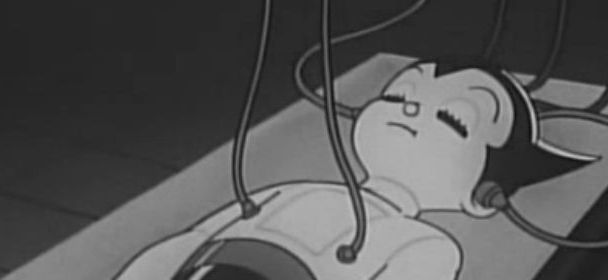Astro Boy
Episodes 1 and 3: “The Birth of Astro Boy” and “Adventure on — Mars”
Original airdates (Japan): Jan. 1 and Jan. 15, 1963
Original airdates (U.S.): Sept. 7 and Sept. 15, 1963
*Some quick notes: I’m providing the Japanese episode numbers and titles, along with both Japanese and U.S. air dates whenever available. I’m watching the dubbed versions from legitimate sources. For this week, I’m watching the episodes on Amazon Instant Video (as Netflix had a delay with the first disc). The remaining episodes will be viewed from the Astro Boy Ultra Collector’s Edition sets released by Right Stuf in 2006.
Today marks the 50th anniversary of the initial broadcast of Astro Boy (Tetsuwan Atomu) on Fuji TV. After enjoying success as a manga, this series, created by Osamu Tezuka’s Mushi Productions, achieved a remarkable 27.4 percent viewership rating on January 1, 1963.
It served as a testament, particularly within Japan, to the viability of animation as a television programming source. Prior to the series’ launch, merchandising and sponsorship, including support from a confectionery company, were secured.
It didn’t take long for the series to gain international attention, especially in the United States.
It attracted the attention of NBC Enterprises executives who were in search of content to distribute to stations across the nation through syndication (though Astro Boy wasn’t nationally broadcast by NBC).
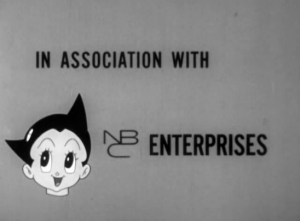
They enlisted the services of Fred Ladd to oversee the direction and adaptation of the series.
Ladd’s responsibilities included addressing issues that conflicted with NBC’s standards and practices, even though these elements were entirely acceptable in Japan, such as violence, occasional eroticism, and culturally-specific humor.
Ladd’s book recounts some of the early stages of this process, highlighting the rapid pace at which episodes were written and dubbed in New York. It delves into the challenges Ladd encountered while modifying episodes to conform to standards and practices requirements.
He also discusses his initial difficulties in explaining to Tezuka and the other Japanese animators why changes needed to be made to the series.
At first, Tezuka suspected Ladd was an NBC spy, but their relationship quickly evolved into a close friendship, with Tezuka eventually bestowing upon Ladd the title of the godfather of Astro Boy for his pivotal role in making Astro Boy a success in the United States.
Although it wasn’t the very first animated program to grace Japanese television (that distinction belongs to Instant History’s brief segments in 1961–1962), Astro Boy holds the honor of being the first weekly series produced and remains a pioneer among the numerous Japanese animated programs that later found their way to U.S. screens.
Consequently, this series carries historical significance for both Japan and the United States, which is why I decided to dedicate an entire month to exploring some of its 100-plus episodes.
In the present week, my viewing included “The Birth of Astro Boy,” which serves as the obvious “pilot” episode of the series, rendering it indispensable for understanding its origins.
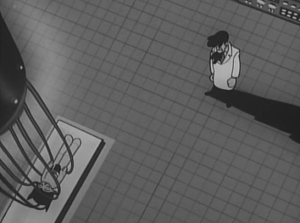
Additionally, I watched “Adventure on — Mars,” a selection of particular significance since Fred Ladd utilized it to persuade NBC Enterprises executives of the series’s value as a marketable property.
Both of these episodes also serve as a testament to Tezuka’s boundless imagination and his determination to showcase Mushi Production’s capability to deliver a high-quality product.
Also Read: Review: Oniisama e…, “The Magnificent Ones”
Achieving this level of quality involved certain compromises in the animation process. Full animation, akin to Disney’s approach, simply wasn’t feasible.
It would have demanded more animators than Japan could muster in the early ’60s and incurred such high costs that Mushi wouldn’t have been profitable.
To address these challenges, Mushi employed limited animation techniques, which involved cutting frames from every drawing, animating only specific parts of the image, and other similar methods.
(Upon watching the initial Astro Boy episodes, Ladd reportedly remarked to author Frederik L. Schodt that it was a case of “LIMITED animation run amuck!”) While limited animation is often associated with anime, and Mushi’s adoption of this style helped popularize it in Japan, it’s worth noting that they weren’t the pioneers in this approach.
United Productions of America and Hanna-Barbera both utilized limited animation in their cartoons during the 1950s and 1960s, although perhaps not to the same extent as Mushi.
I’ve previously discussed limited animation in my coverage of Oniisama e…, so I won’t dwell on this aspect, but it’s crucial to grasp the animation techniques employed in many anime series from this era.
Limited animation intentionally departs from pursuing “realism,” and, as Schodt aptly points out, it shifts the focus to “story, character development, and emotional impact.”
This concept was certainly realized to its fullest extent in Oniisama. However, in the case of Astro Boy, the animators were still in the process of learning how to effectively translate these ideas from the page to the screen.
Both episodes this week exemplify the extensive efforts Tezuka and the Mushi team were making in these aspects. “The Birth of Astro Boy” commences with the tragic death of Tobi Tenma (known as Astor Boynton III in the English language dub) in a car accident.
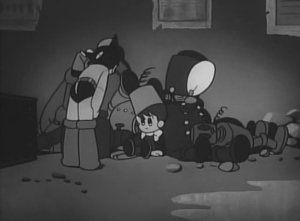
Overwhelmed by the loss of his son, Dr. Tenma (referred to as Dr. Boynton) embarks on the ambitious endeavor of constructing a lifelike replica of the boy, utilizing all the resources available at the Institute of Science, and christens this creation Astro Boy.
Commencing a story with the death of a child isn’t the most uplifting start, and this episode continues to explore the theme of darkness throughout. Tenma/Boynton is clearly consumed by grief, but the true darkness of the episode emerges when he realizes that his robotic son can never truly be a real boy.
This leads him to make the harrowing decision to sell Astro to the robot circus, complete with contractual agreements and a disownment of Astro as his son.
The writing in “The Birth of Astro Boy” doesn’t conform to the typical kid-friendly, gag-centric style that one might expect from animated programs of the 1960s.
While there are moments of humor as Astro adapts to his life as a robot boy, such as torn curtains, smashed alarm clocks, and calculator eyes, it’s almost easy to forget these instances of humor in light of the gravity of Tenma/Boynton’s rejection of his own creation.
When you speak with individuals who enjoy anime or inquire about their reasons for starting to watch, a comparatively more mature style of storytelling often emerges as a common motivator.
“The Birth of Astro Boy” demonstrates that this inclination was present right from the inception of the medium, owing much to years of manga also exhibiting a similarly bold approach.
Upon his arrival at the circus, Astro is thrust into gladiator-style combat against another robot, one significantly larger in size. Astro’s pacifist nature leads to him enduring a series of beatings until he’s compelled to defend himself, ultimately defeating the larger robot, though he refrains from destroying it entirely.
The interruption of this battle comes in the form of Dr. Ochanomizu (known as Dr. Packerdermus J. Elefun), the new head of the Institute of Science.
Ochanomizu’s impassioned speech directed at the circus’s owner, Hamegg (referred to as Cacciatore), marks the inception of a recurring theme in Astro Boy: that of robot rights and discrimination, a subject that will feature prominently in the series.
Once again, the series delves into more complex thematic issues than what was typical in animated content of the era.
The juxtaposition of the contracts and legal justifications Hamegg employs to legitimize his use of robots in the circus and the deplorable conditions in which these robots exist, often without sufficient power to function properly, invites an American audience to draw parallels with the concept of slavery.
However, the series has a broader aim, seeking to highlight the overarching issues of discrimination and prejudice, not only from individuals but also from civil institutions.
By the episode’s conclusion, Ochanomizu successfully advocates for a robot rights bill to the global government, thereby liberating robots from the classification of property.
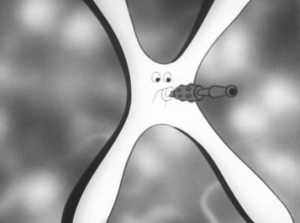
The theme of discrimination reemerges in “Adventure on — Mars” as Captain Daring refuses to accept Astro Boy as the commander of the second manned mission to Mars. Daring persistently undermines Astro by disregarding orders, displaying a general disdain, and even severing Astro Boy’s tether to the rocket ship, leaving him stranded in space.
In due course, Daring leads a mutiny against Astro, going to the extent of removing Astro’s activator tube, rendering the robot powerless.
Daring eventually recognizes the error of his ways and sacrifices himself to protect Astro and the rest of the crew when intergalactic aliens invade Mars.
Astro pays tribute to the fallen astronaut with a proper salute as he speeds off into the Martian horizon, concluding the episode.
Unlike shows like Super Friends, which often addressed social issues in a heavy-handed manner (as Andy and I frequently noted), Astro Boy incorporates these themes more subtly—and a full decade earlier.
These issues aren’t presented as straightforward public service announcements but rather as central themes for the series to explore, utilizing robots as proxies for the less privileged. It’s classic science fiction extrapolation, and Astro Boy excels in its execution.
In addition to its thought-provoking themes, science fiction wouldn’t be complete without a touch of wonder and whimsy. Both episodes manage to infuse some humor into the narrative while simultaneously showcasing Mushi’s animation prowess.
“The Birth of Astro Boy” treats viewers to the amusing robot circus parade, which brims with small delights.
Meanwhile, “Adventure on — Mars” takes us on a whimsical journey across the galaxy, introducing a host of peculiar creations that primarily serve the purpose of humor since these aliens don’t reappear in the episode.
“Adventure on — Mars” offers numerous scenes that add a dose of levity, such as the comical launch from Earth, which ends with the entire crew (except for Astro) being flattened, requiring them to be pumped back full of oxygen like balloons, often with amusing results.
Both episodes also deliver plenty of action, with “Adventure on — Mars” being particularly action-packed, featuring thrilling set pieces that make it an exciting installment (which is hardly surprising that Ladd chose it to showcase the series’s strengths).
Despite the constraints of limited animation, the rapid cuts and Astro’s lightning-fast movements across the frame inject the scenes with a palpable sense of energy, whether it’s our hero battling invading aliens or the robot tank obliterating their ships.
Next week: “Time Machine” (episode 11 (Japan) / 18 (U.S.)) and “Führer ZZZ” (episode 30 (Japan)) / “Secret Agent 3-Z” (episode 15 (U.S.))
***
As I was all set to embark on another animated series following Astro Boy, the process of selecting the next show proved to be more challenging than I initially expected. With my own interests and the convenience of streaming and affordable DVDs in mind, I decided to put the idea of another animated series on hold and explore an alternative option.
This shift in direction was influenced by my friend Charlotte Howell’s blog post, which highlighted the significance of Wonder Woman.
I couldn’t help but consider the idea of delving into the late 1970s Wonder Woman series, viewing it as an enjoyable and potentially productive endeavor.
To add an extra layer of intrigue, I invited our Teen Dreams columnist, Kerensa, to join me in watching the series. I’m thrilled to say she eagerly accepted, and we’re both eager to commence our viewing experience.
Kerensa has only seen the pilot movie that aired in 1975 on ABC (not to be confused with the 1974 pilot movie featuring Cathy Lee Crosby), while my exposure has been limited to a few episodes from the CBS years.
However, Kerensa is a dedicated Wonder Woman fan, and while I’ve always appreciated the character from appearances in Super Friends and Justice League, I’m now gaining a deeper understanding of her through her current depictions in the new 52 comics and older issues.
I believe I can speak for both of us when I say we’re enthusiastic about getting to know this iconic character through the lens of 1970s television, recognizing the cultural context of that era (complete with the ‘jiggle TV’ phenomenon).
What’s even more exciting is that if you don’t have the DVDs or prefer not to rent or buy them (although they are quite affordable), you can watch nearly the entire show for free on TheWB.com, depending on your location.
They do have a few episodes missing from season 3, but that’s a bit down the road, and Kerensa and I aren’t yet sure how far we’ll go. We’re committed to covering all of season 1, and after that, we’ll assess our individual interests in continuing with the series.
Of course, any network changes and retooling will prompt us to at least take a quick look at what season 2 has in store!
To enhance our journey, Kerensa and I will also delve into Elena Levine’s book, “Wallowing in Sex: The New Sexual Culture of 1970s America Television.” We may or may not frequently reference the book, and it’s not a requirement for those who want to watch Wonder Woman along with us (it won’t be structured like the book club coverage we’ve done on the site before).
We’re reading it to help fill in some knowledge gaps and provide context to the series for our personal enrichment.
Our coverage of Wonder Woman will kick off on February 5 with “The New Original Wonder Woman,” a 90-minute made-for-TV movie that originally aired on November 7, 1975.


